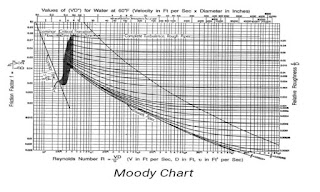Head Loss
The head loss that
occurs in pipes is dependent on the flow velocity, pipe length and diameter,
and a friction factor based on the roughness of the pipe and
the Reynolds
number of the flow. The
head loss that occurs in the components of a flow path can be correlated to a
piping length that would cause an equivalent head loss.
Head Loss
Head loss is a measure of the reduction in the
total head (sum of elevation
head, velocity head and pressure head) of the fluid as it moves through a fluid system. Head loss is
unavoidable in real fluids
It is present because of: the friction between
the fluid and the walls of the pipe; the friction between adjacent fluid
particles as they move relative to one another
and the turbulence caused whenever the flow is
redirected or affected in any way by such components as piping entrances and
exits, pumps, valves, flow reducers, and fittings
Frictional loss is that part of the total head loss that
occurs as the fluid flows through straight pipes
The head loss for
fluid flow is directly proportional to the length of pipe, the square of the
fluid velocity, and a term accounting for fluid friction called the friction
factor. The head loss is inversely proportional to the diameter of the pipe.
Friction Factor
The friction factor
has been determined to depend on the Reynolds
number for the flow and
the degree of roughness of the pipe's inner surface
The quantity used to
measure the roughness of the pipe is called the relative roughness, which
equals the average height of surface irregularities (ε) divided by the pipe diameter (D)
Relative Roughness=εD
The value of the friction factor is usually obtained from the Moody Chart, an example of which is shown below. The Moody Chart can be used to determine the friction factor based on the Reynolds number and the relative roughness
Example
Determine the friction factor (f) for fluid flow in a pipe
that has a Reynolds number of 40,000 and a relative roughness of 0.01.
Solution
Using the Moody Chart, a Reynolds number of 40,000 intersects
the curve corresponding to a relative roughness of 0.01 at a friction factor of
0.04
Darcy's
Equation
The frictional head
loss can be calculated using a mathematical relationship that is known as
Darcy's equation for head loss. The equation takes two distinct forms. The
first form of Darcy's equation determines the losses in the system associated
with the length of the pipe
where:
|
f |
= |
friction factor
(unitless) |
|
L |
= |
length of pipe (ft) |
|
D |
= |
diameter of pipe
(ft) |
|
v |
= |
fluid velocity
(ft/sec) |
|
g |
= |
gravitational
acceleration (ft/sec2) |
Minor Losses
The losses that occur
in pipelines due to bends, elbows, joints, valves, etc. are sometimes
called minor losses. This is a misnomer because in many cases these
losses are more important than the losses due to pipe friction
considered in the
preceding section. For all minor losses in turbulent
flow, the head loss varies
as the square of the velocity. Thus a convenient method of expressing the minor
losses in flow is by means of a loss coefficient (k).
Values of the loss coefficient (k) for typical situations and fittings is found
in standard handbooks. The form of Darcy's equation used to calculate minor
losses of individual fluid system components is expressed by Equation








ليست هناك تعليقات:
إرسال تعليق